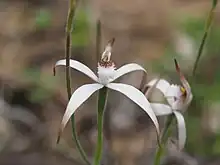| Caladenia hirta | |
|---|---|
 | |
| Scientific classification | |
| Kingdom: | Plantae |
| Clade: | Tracheophytes |
| Clade: | Angiosperms |
| Clade: | Monocots |
| Order: | Asparagales |
| Family: | Orchidaceae |
| Subfamily: | Orchidoideae |
| Tribe: | Diurideae |
| Genus: | Caladenia |
| Species: | C. hirta |
| Binomial name | |
| Caladenia hirta | |
| Synonyms[1] | |
| |
Caladenia hirta, commonly known as sugar candy orchid,[2] flowering plant in the orchid family Orchidaceae and endemic to the south-west of Western Australia. It is a ground orchid with a single broad, hairy leaf and up to six white or pink and white flowers with pink markings.
Description
Caladenia hirta is a terrestrial, perennial, deciduous, sympodial herb with a single, erect or ground-hugging, broadly linear leaf 40–200 mm (1.6–7.9 in) long and 5–20 mm (0.20–0.79 in) wide. The plant is 10–60 mm (0.39–2.36 in) high with up to six white or pink and white flowers 40–200 mm (1.6–7.9 in) long and 30–50 mm (1.2–2.0 in) wide. The dorsal sepal is erect and curves forward, 15–35 mm (0.59–1.38 in) long and 2.5–3.5 mm (0.098–0.138 in) wide, the lateral sepals 15–37 mm (0.59–1.46 in) long and 3–7 mm (0.12–0.28 in) wide, and the petals 10–35 mm (0.39–1.38 in) long and 2–4 mm (0.079–0.157 in) wide. The labellum is white, 10–20 mm (0.39–0.79 in) long and 5–8 mm (0.20–0.31 in) wide with 4 rows of pink calli along its centre. Flowering time depends on subspecies.[3][4][5]
Taxonomy and naming
Caladenia hirta was first formally in 1840 by John Lindley in A Sketch of the Vegetation of the Swan River Colony.[6][7]
In 2001, Stephen Hopper and Andrew Phillip Brown described two subspecies of Caladenia hirta in the journal Nuytsia and the names are accepted by the Australian Plant Census:
- Caladenia hirta R.Br. subsp. hirta[8] - candy orchid, has pale creamy-pink flowers from September to November, with a leaf 60–200 mm (2.4–7.9 in) long, the lateral sepals and petals 20–40 mm (0.79–1.57 in) long.[5][9]
- Caladenia hirta subsp. rosea Hopper & A.P.Br. [10] - pink candy orchid, has rose-pink flowers from June to September, with a leaf 40–100 mm (1.6–3.9 in) long, the lateral sepals and petals 10–20 mm (0.39–0.79 in) long.[5][11]
Distribution and habitat
Candy orchid is a common subspecies of C. hirta and grows in Banksia, tuart and peppermint woodland between Arrowsmith and Albany in the Avon Wheatbelt, Esperance Plains, Geraldton Sandplains, Jarrah Forest, Swan Coastal Plain and Warren bioregions of south-west Western Australia.[5][9] Pink candy orchid is also common and widespread, often growing on granite outcrops, on the edges of salt lakes, and other moist areas, between Kalbarri and Israelite Bay in the Avon Wheatbelt, Coolgardie, Esperance Plains, Geraldton Sandplains, Jarrah Forest, Mallee, Murchison, Swan Coastal Plain, Warren and Yalgoo bioregions.[5][11]
References
- 1 2 "Caladenia hirta". Australian Plant Census. Retrieved 7 February 2023.
- ↑ "Caladenia hirta". FloraBase. Western Australian Government Department of Biodiversity, Conservation and Attractions.
- ↑ Brown, Andrew P.; Dixon, Kingsley W.; French, Christopher; Brockman, Garry (2013). Field guide to the orchids of Western Australia : the definitive guide to the native orchids of Western Australia. Floreat, W.A.: Simon Neville Publications. pp. 144–145. ISBN 9780980348149.
- ↑ Hoffman, Noel; Brown, Andrew (2011). Orchids of South-West Australia (3rd ed.). Gooseberry Hill: Noel Hoffman. pp. 170–171. ISBN 9780646562322.
- 1 2 3 4 5 Brown, Andrew P.; Hopper, Stephen (2001). "Contributions to Western Australian orchidology: 2. New taxa and circumscriptions in Caladenia". Nuytsia. 14 (1/2): 87–90. Retrieved 7 February 2023.
- ↑ "Caladenia hirta". APNI. Retrieved 7 February 2017.
- ↑ Lindley, John (1840). A Sketch of the Vegetation of the Swan River Colony. London: James Ridgway. p. lii. Retrieved 7 February 2023.
- ↑ "Caladenia hirta subsp. hirta". Australian Plant Census. Retrieved 7 February 2023.
- 1 2 "Caladenia hirta subsp. hirta". FloraBase. Western Australian Government Department of Biodiversity, Conservation and Attractions.
- ↑ "Caladenia hirta subsp. rosea". Australian Plant Census. Retrieved 7 February 2023.
- 1 2 "Caladenia hirta subsp. rosea". FloraBase. Western Australian Government Department of Biodiversity, Conservation and Attractions.
External links
![]() Media related to Caladenia hirta at Wikimedia Commons
Media related to Caladenia hirta at Wikimedia Commons